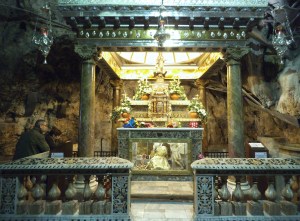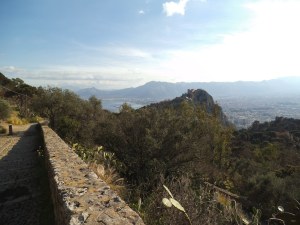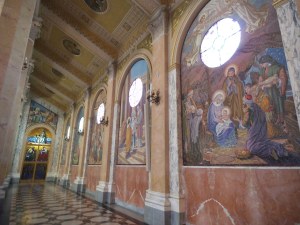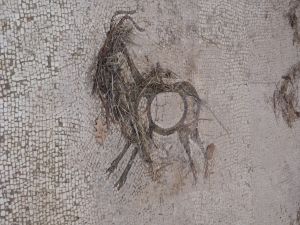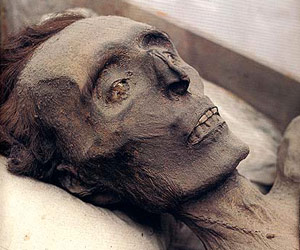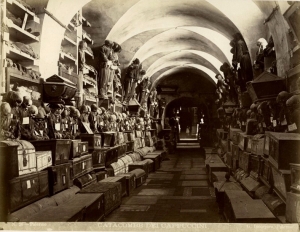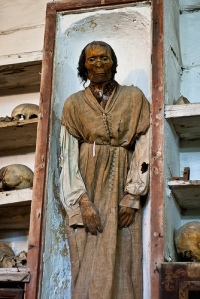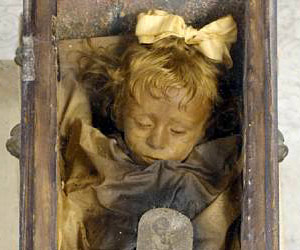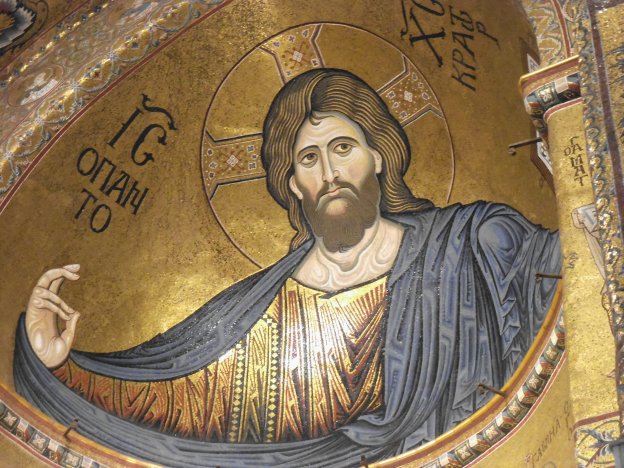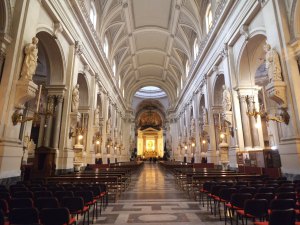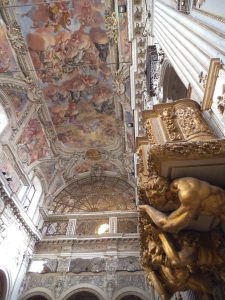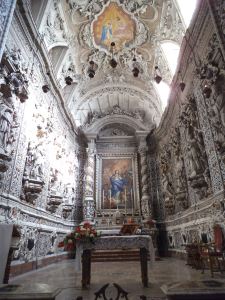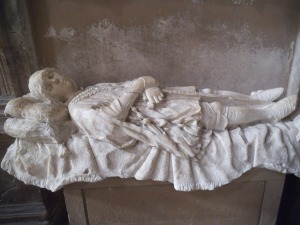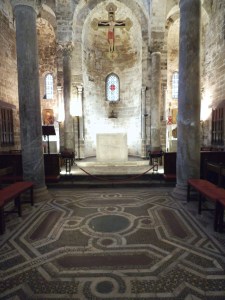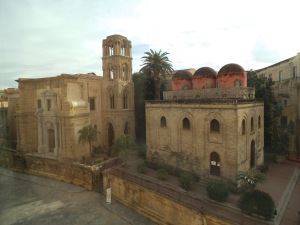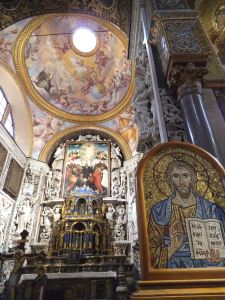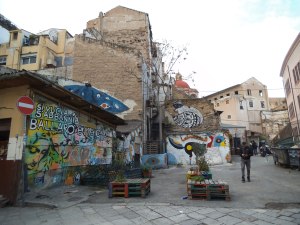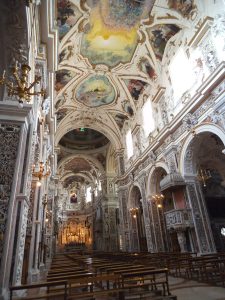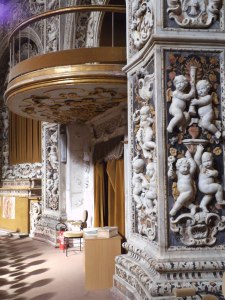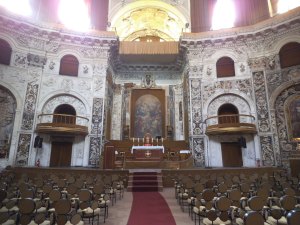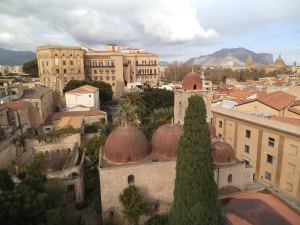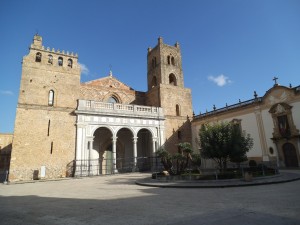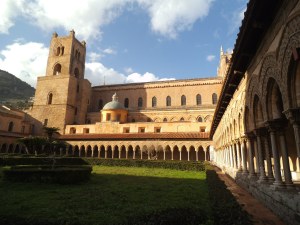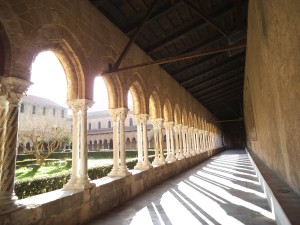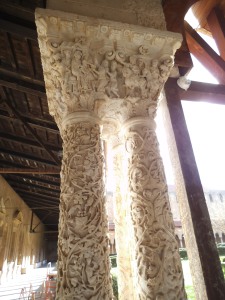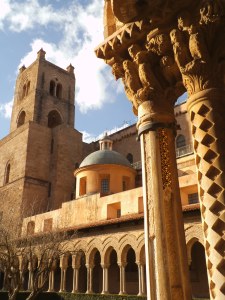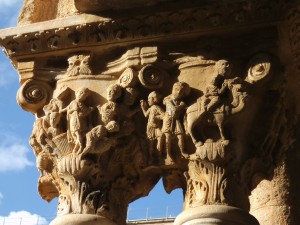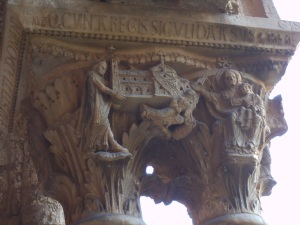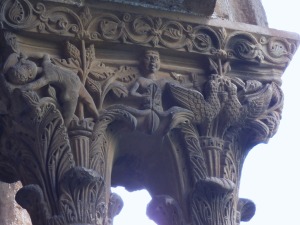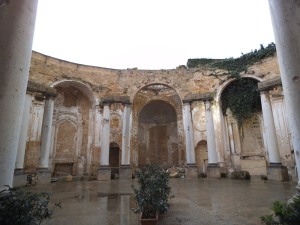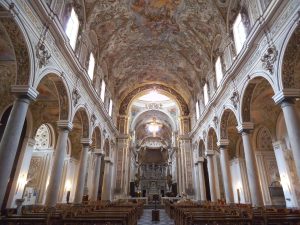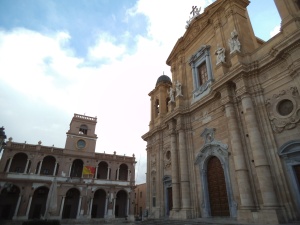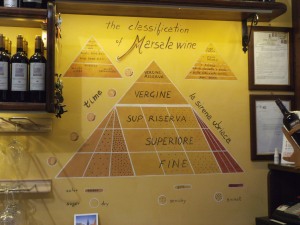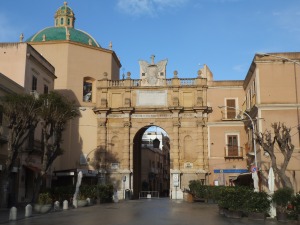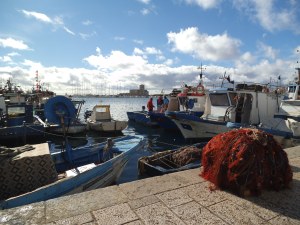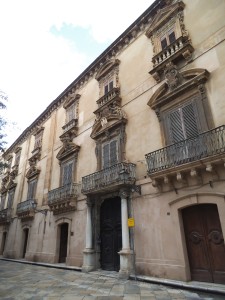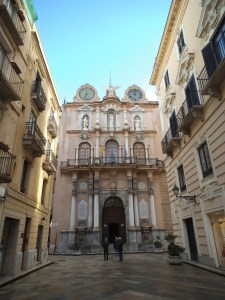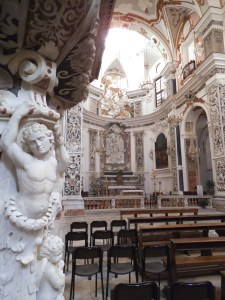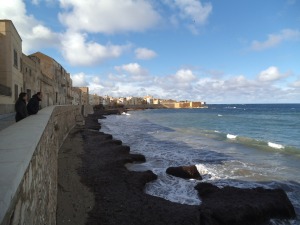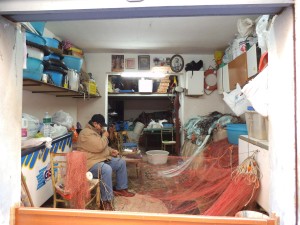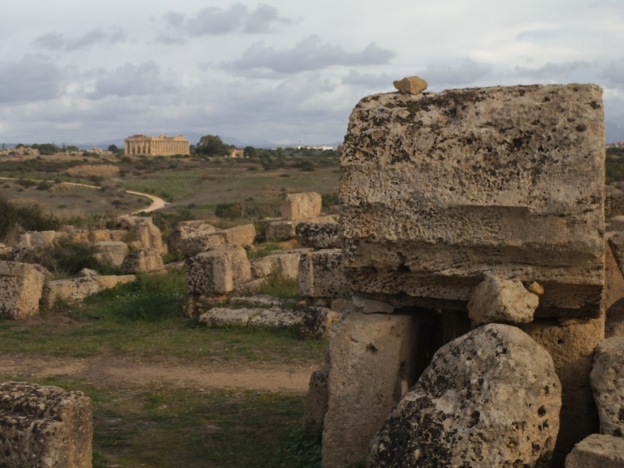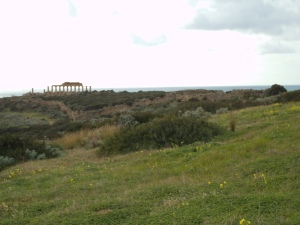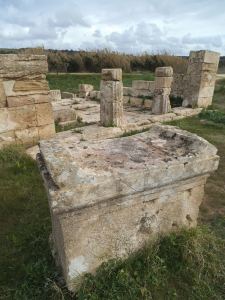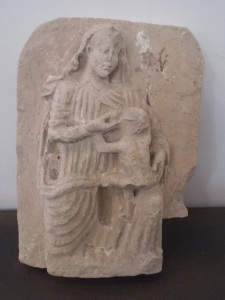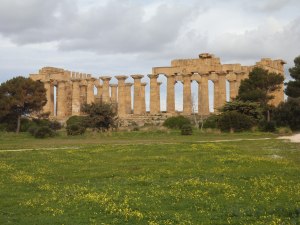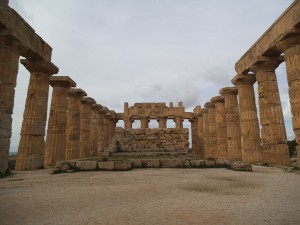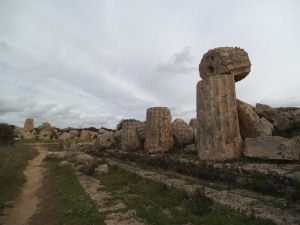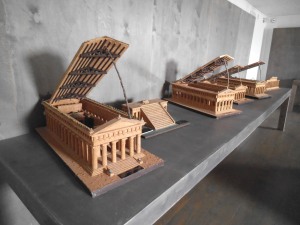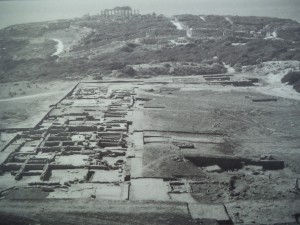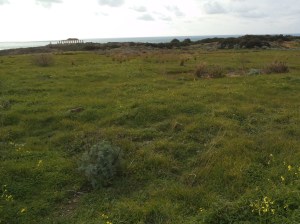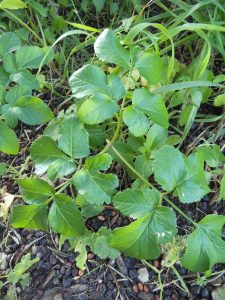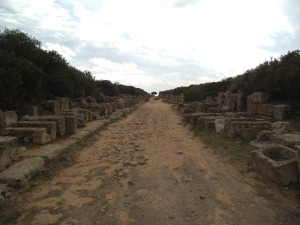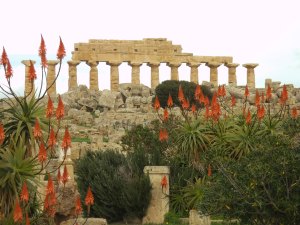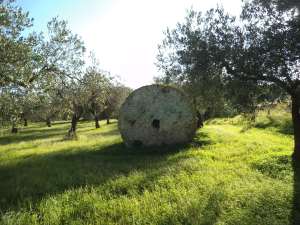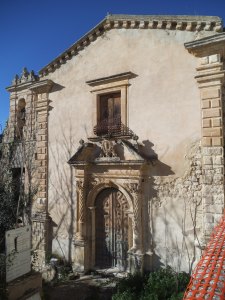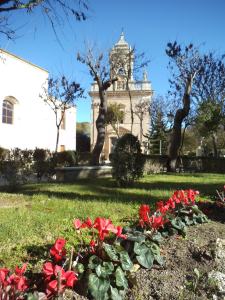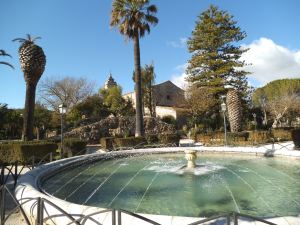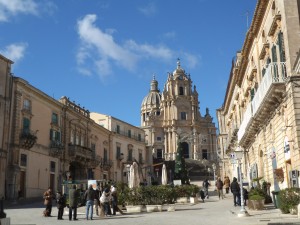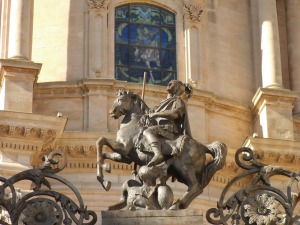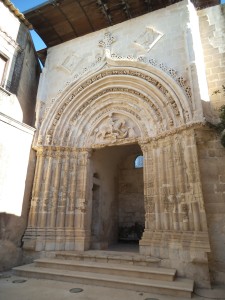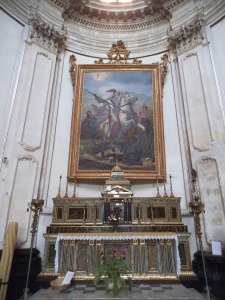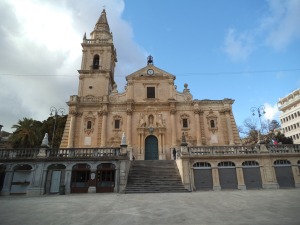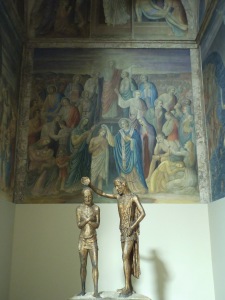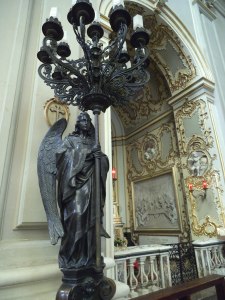 It’s not an auspicious start to my pilgrimage up Monte Pellegrino, a large rocky promontory to the west of Palermo. I’ve decided to catch the bus up the mountain but I’m standing on the wrong side of the road. Luckily, the driver has seen enough wayward tourists to realise my intended destination and stops to beckon me over. There’s only one other passenger and he seems intent on explaining the best spot for the views. This seems to be up front, next to the driver who is swinging wildly round hairpin bends with one hand. In the other is a cigarette. He honks his horn loudly at each blind bend to warn oncoming traffic of his intent (not to stop) and narrowly overtakes the masochistic cyclists who are practising to be ‘King of the Mountains’.
It’s not an auspicious start to my pilgrimage up Monte Pellegrino, a large rocky promontory to the west of Palermo. I’ve decided to catch the bus up the mountain but I’m standing on the wrong side of the road. Luckily, the driver has seen enough wayward tourists to realise my intended destination and stops to beckon me over. There’s only one other passenger and he seems intent on explaining the best spot for the views. This seems to be up front, next to the driver who is swinging wildly round hairpin bends with one hand. In the other is a cigarette. He honks his horn loudly at each blind bend to warn oncoming traffic of his intent (not to stop) and narrowly overtakes the masochistic cyclists who are practising to be ‘King of the Mountains’.
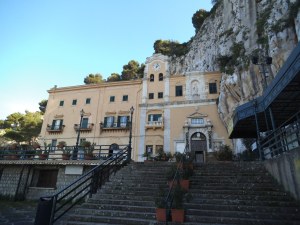 We reach the sanctuary of Santa Rosalia in one piece and I give an offering in thanks for my safe arrival. Rosalia was probably the daughter of the Duke of Sinibaldo who decided to reject her wealthy life and live as a hermit in one of the caves on the mountain and ultimately died there in 1166. Her bones were miraculously rediscovered in 1624, just in time to save the city of Palermo from the plague, and since then she has been honoured as the patron saint of the city.
We reach the sanctuary of Santa Rosalia in one piece and I give an offering in thanks for my safe arrival. Rosalia was probably the daughter of the Duke of Sinibaldo who decided to reject her wealthy life and live as a hermit in one of the caves on the mountain and ultimately died there in 1166. Her bones were miraculously rediscovered in 1624, just in time to save the city of Palermo from the plague, and since then she has been honoured as the patron saint of the city.
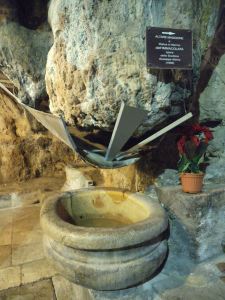 Her cave is now hidden behind the Baroque façade of a church, but inside it is still just a cave. The ‘miraculous’ water dripping down the walls is captured by metal plates artistically arranged to direct it into a stone basin.
Her cave is now hidden behind the Baroque façade of a church, but inside it is still just a cave. The ‘miraculous’ water dripping down the walls is captured by metal plates artistically arranged to direct it into a stone basin.
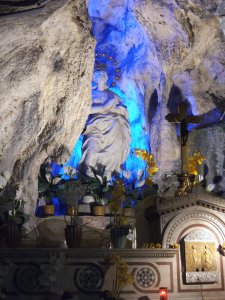 Rosalia is everywhere – a statue in a glass coffin with one of her bones in a reliquary, another smaller statue on top with a tooth embedded in its heart, a bust half hidden in a cavity above, another statue at the end and a fresco on the wall. In the entrance are traditional silver votive offerings as well as less traditional ones which mostly seem to be children’s clothes or toys, though I do spy the odd football scarf.
Rosalia is everywhere – a statue in a glass coffin with one of her bones in a reliquary, another smaller statue on top with a tooth embedded in its heart, a bust half hidden in a cavity above, another statue at the end and a fresco on the wall. In the entrance are traditional silver votive offerings as well as less traditional ones which mostly seem to be children’s clothes or toys, though I do spy the odd football scarf.
 I return to Palermo on foot using a very scenic cobbled pilgrim’s path which passes through the pine forest and then zig-zags down a gorge where it finally emerges into frantic downtown traffic. I pass a few more masochistic cyclists who for some reason are straining up the cobbled path instead of the smooth tarmac road. Perhaps it is their form of penance.
I return to Palermo on foot using a very scenic cobbled pilgrim’s path which passes through the pine forest and then zig-zags down a gorge where it finally emerges into frantic downtown traffic. I pass a few more masochistic cyclists who for some reason are straining up the cobbled path instead of the smooth tarmac road. Perhaps it is their form of penance.
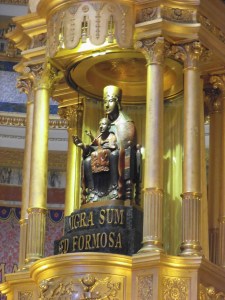 100 kms to the east I’m driving to another rocky promontory (there are quite a few along the north coast of Sicily) to visit another religious sanctuary. This one is dedicated to a Byzantine Black Madonna which arrived from Constantinople in the 9th century and has been known to perform miracles, such as producing a soft cushion of sand to break the fall of a child who fell from the cliffs above.
100 kms to the east I’m driving to another rocky promontory (there are quite a few along the north coast of Sicily) to visit another religious sanctuary. This one is dedicated to a Byzantine Black Madonna which arrived from Constantinople in the 9th century and has been known to perform miracles, such as producing a soft cushion of sand to break the fall of a child who fell from the cliffs above.
I arrive at the large lower car park and find it completely empty with no sign of the promised shuttle bus, so I continue up the road and park in the higher disabled parking area which is also completely empty. After several months of observing the driving rules (or rather lack of them) in Greece and Italy, I’ve finally gone native.
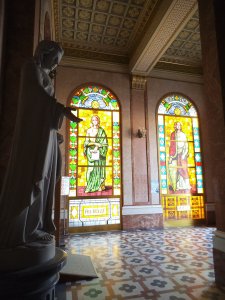 The sanctuary was built in the 1960’s to replace a much smaller chapel but it’s not over-the-top like many others I have visited, In fact it’s quite tasteful with paintings of the life and death of Jesus lining the walls, colourful stained-glass window of saints and a large apse where the Black Madonna is enthroned, looking down upon those who have come to pray for her help.
The sanctuary was built in the 1960’s to replace a much smaller chapel but it’s not over-the-top like many others I have visited, In fact it’s quite tasteful with paintings of the life and death of Jesus lining the walls, colourful stained-glass window of saints and a large apse where the Black Madonna is enthroned, looking down upon those who have come to pray for her help.
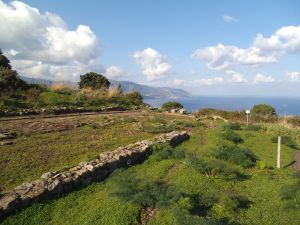 Beyond the sanctuary is the archaeological site of Tyndaris. It’s a beautiful sunny day and I’m keen to clamber around some more Roman remains but I’m to be disappointed for this is one of the poorest maintained sites that I have visited in Sicily. There are no information boards, even in Italian, and no marked pathways. The paths that do exist are completely overgrown, and very wet after a night of showers, and high wire fences stop me from reaching any decent viewpoints.
Beyond the sanctuary is the archaeological site of Tyndaris. It’s a beautiful sunny day and I’m keen to clamber around some more Roman remains but I’m to be disappointed for this is one of the poorest maintained sites that I have visited in Sicily. There are no information boards, even in Italian, and no marked pathways. The paths that do exist are completely overgrown, and very wet after a night of showers, and high wire fences stop me from reaching any decent viewpoints.
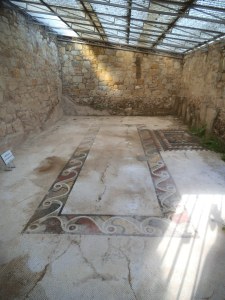 I’m a little placated when I finally find the partially restored Basilica and a Roman house which has some interesting mosaic floors, though these would be even better if someone bothered to sweep and clean them occasionally. I’m tempted to ask for my money back but the staff at the reception desk made it quite clear that they didn’t understand any English and my Italian is certainly not good enough to argue my case.
I’m a little placated when I finally find the partially restored Basilica and a Roman house which has some interesting mosaic floors, though these would be even better if someone bothered to sweep and clean them occasionally. I’m tempted to ask for my money back but the staff at the reception desk made it quite clear that they didn’t understand any English and my Italian is certainly not good enough to argue my case.

 As I leave I spot a police car that has driven up to the viewpoint. It’s unclear whether it is patrolling or if the occupants just want a nice view for their coffee break. It makes me wonder if Trixie might have been penalised for her poor choice of parking spot but when I get back to the car park there is no ticket, no clamp and not even any other cars. Perhaps I’m being protected by the Black Madonna or, more likely I’m just benefitting from the laissez-faire attitude of the Italian police.
As I leave I spot a police car that has driven up to the viewpoint. It’s unclear whether it is patrolling or if the occupants just want a nice view for their coffee break. It makes me wonder if Trixie might have been penalised for her poor choice of parking spot but when I get back to the car park there is no ticket, no clamp and not even any other cars. Perhaps I’m being protected by the Black Madonna or, more likely I’m just benefitting from the laissez-faire attitude of the Italian police.


